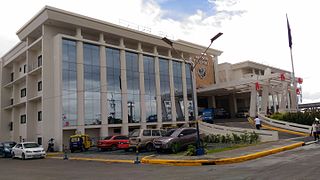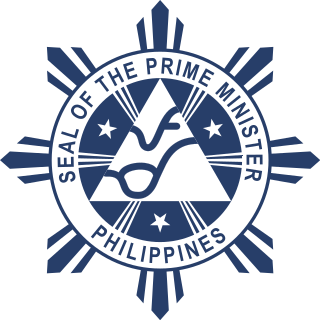
A city is one of the units of local government in the Philippines. All Philippine cities are chartered cities, whose existence as corporate and administrative entities is governed by their own specific municipal charters in addition to the Local Government Code of 1991, which specifies their administrative structure and powers. As of July 8, 2023, there are 149 cities.

Bacoor, officially the City of Bacoor, is a 1st class component city in the province of Cavite, Philippines. According to the 2020 census, it has a population of 664,625 people, making it the 15th most populous city in the Philippines and the second largest city in the province of Cavite after Dasmariñas.
Elections in the Philippines are of several types. The president, vice-president, and the senators are elected for a six-year term, while the members of the House of Representatives, governors, vice-governors, members of the Sangguniang Panlalawigan, mayors, vice-mayors, members of the Sangguniang Panlungsod/members of the Sangguniang Bayan, barangay officials, and the members of the Sangguniang Kabataan are elected to serve for a three-year term.

The prime minister of the Philippines was the official designation of the head of the government of the Philippines from 1978 until the People Power Revolution in 1986. During martial law and the fourth republic, the prime minister served as the head the Armed Forces of the Philippines. A limited version of this office, officially known as the President of the Council of Government, existed temporarily in 1899 during the First Philippine Republic.

The government of the Philippines has three interdependent branches: the legislative, executive, and judicial branches. The Philippines is governed as a unitary state under a presidential representative and democratic constitutional republic in which the president functions as both the head of state and the head of government of the country within a pluriform multi-party system.
The Philippines is divided into four levels of administrative divisions, with the lower three being defined in the Local Government Code of 1991 as local government units (LGUs). They are, from the highest to the lowest:
- Regions are mostly used to organize national services. Of the 17 regions, only one—the Bangsamoro Autonomous Region in Muslim Mindanao—has an elected government to which the central government has devolved competencies.
- Provinces, independent cities, and one independent municipality (Pateros)
- Component cities and municipalities within a province
- Barangays within a city or municipality
This list of presidential elections in the Philippines includes election results of both presidential and vice presidential elections since 1899 with the candidates' political party and their corresponding percentage.
The Philippine constitutional plebiscite of 1973 occurred from 10 to 15 January which ratified the 1973 Constitution of the Philippines.
The Sangguniang Bayan is the local legislative branch of the municipal governments in the Philippines. It is responsible for passing ordinances and resolutions for the administration of a municipality. Its powers are defined by the Local Government Code, passed by Congress in 1991.
The Constitution of the Philippines is the constitution or the supreme law of the Republic of the Philippines. Its final draft was completed by the Constitutional Commission on October 12, 1986, and ratified by a nationwide plebiscite on February 2, 1987.
In the Philippines, local government is divided into three levels: provinces and independent cities, component cities and municipalities, and barangays, all of which are collectively known as local government units (LGUs). In some areas, above provinces and independent chartered cities are autonomous regions, such as the Bangsamoro Autonomous Region in Muslim Mindanao. Some towns and cities remit their revenue to national government and is returned through the national government through a process called internal revenue allotment. Below barangays in some cities and municipalities are sitios and puroks. All of these, with the exception of sitios and puroks, elect their own executives and legislatures. Sitios and puroks are often but not necessarily led by an elected barangay councilor.
Local elections were held in the Philippines on May 13, 2013, the same day and on the same ballot as national elections. Elected were governors, mayors and council members of Philippine provinces, Philippine cities and Philippine municipalities. Separate elections for barangay officials were held on October.

The Manila City Council or the city's legislature is composed of 38 councilors, with 36 councilors elected from Manila's six councilor districts and two councilors elected from the ranks of barangay (neighborhood) chairmen and the Sangguniang Kabataan. The presiding officer of the council is the Vice Mayor, who is elected citywide.

Local elections were held in Manila on May 9, 2016, as a part of the 2016 Philippine general election. Voters elected candidates for mayor, vice mayor, six congressmen, and the 36 councilors that would be members of the city council. Incumbent mayor Joseph Estrada won the elections, securing him to serve his second three-year term as the mayor of Manila. He won by a slim margin at only more than 2,000 votes against his closest rival, former Manila mayor Alfredo Lim. Dr. Maria Sheilah “Honey” Lacuna-Pangan, daughter of former Manila vice mayor Danny Lacuna, Estrada’s running-mate, topped the vice mayoral race with 268,969 votes.

Manila held its local elections on Monday, May 13, 2019, as a part of the 2019 Philippine general election. Voters elected candidates for mayor, vice mayor, 6 congressmen, and the 36 councilors that would be members of the City Council. There are a total of 736,156 people who voted out of the 1,065,149 city's registered voters. Francisco "Isko Moreno" Domagoso won the elections, enabling him to serve a three-year term as the mayor of Manila. His running mate, the incumbent vice mayor Maria Sheilah "Honey" Lacuna-Pangan, once again topped the vice mayoral race, securing her to serve her second three-year term as the city's vice mayor.

Local elections in the Philippines were held on May 13, 2019. This was conducted together with the 2019 general election for national positions. All elected positions above the barangay (village) level were disputed. The following positions were disputed:
Barangay and Sangguniang Kabataan elections (BSKE) in the Philippines were held on October 30, 2023. The elected barangay and Sangguniang Kabataan officials will begin their terms at noon on November 30, 2023. The barangay is the smallest administrative division in the country.
Referendums in the Philippines are occasionally held at a national, regional or local level. Referendums can either by national or local in scope. In the Philippines, "referendums" and "plebiscites" mean different things.

Local elections were held at Manila on May 9, 2022, as part of the Philippine general election. Held concurrently with the national elections, the electorate voted to elect a mayor, a vice mayor, thirty-six city council members and six district representatives to congress. Those elected took their respective offices on June 30, 2022, for a three-year-long term. 886,133 of 1,133,042 registered voters voted in this election.









